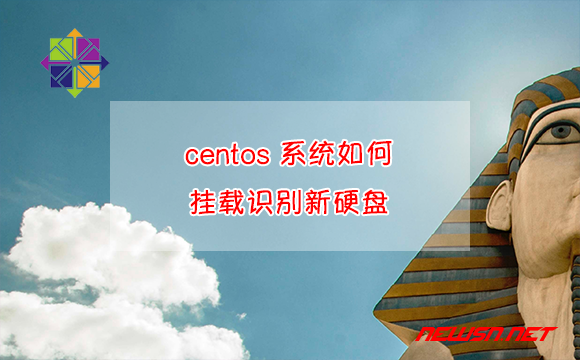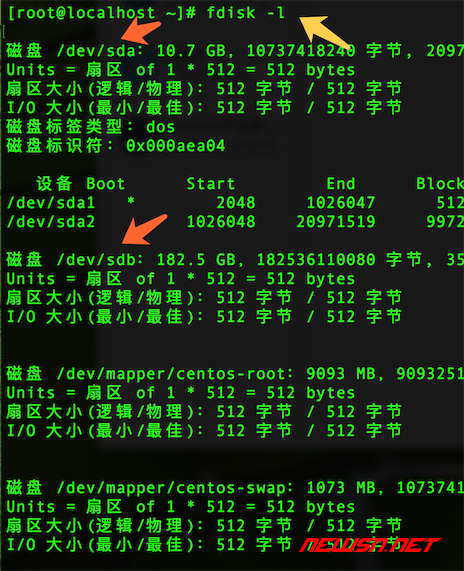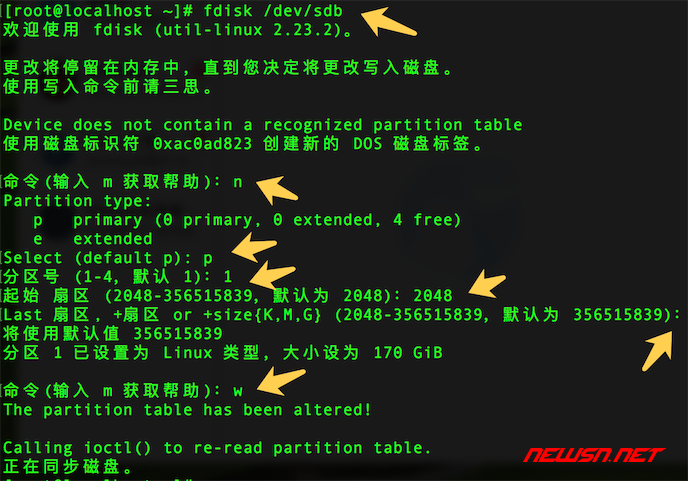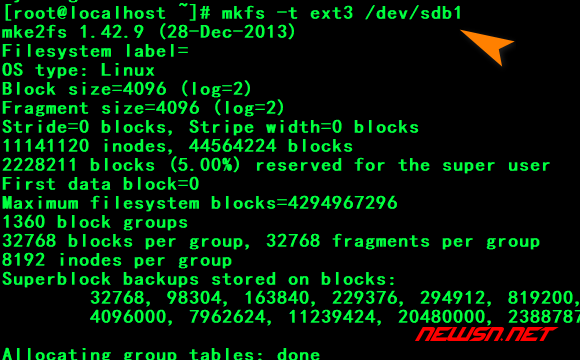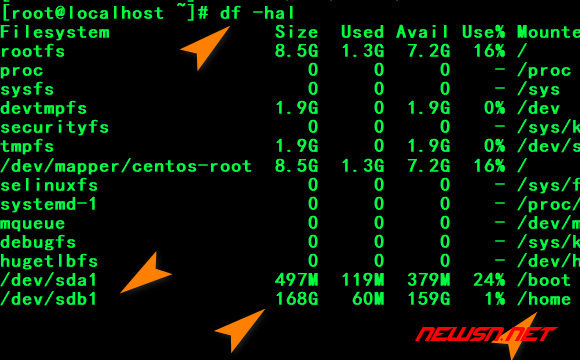centos 系统如何挂载识别新硬盘?
发布于 作者:苏南大叔 来源:程序如此灵动~
linux下面纯正命令行,干什么事情都特别有黑客范。这不,挂载个新硬盘,在window下面是不是个非常简单的事情?linux下面就变得神秘莫测了。下面是教程。大家请保存,linux的云主机必备教程。
本范例中,实验机的操作系统是centos7。
查看基本状况
通过下面的命令,我们可以看到/dev/xvdb(此名称因系统而异)容量有23.6G,而且没有分区。
fdisk -l [root@MyVPS ~]# fdisk -l
Disk /dev/xvda: 8589 MB, 8589934592 bytes
255 heads, 63 sectors/track, 1044 cylinders
Units = cylinders of 16065 * 512 = 8225280 bytes
Device Boot Start End Blocks Id System
/dev/xvda1 * 1 13 104391 83 Linux
/dev/xvda2 14 1044 8281507+ 8e Linux LVM
Disk /dev/xvdb: 23.6 GB, 23622320128 bytes
255 heads, 63 sectors/track, 2871 cylinders
Units = cylinders of 16065 * 512 = 8225280 bytes
Device Boot Start End Blocks Id System分区格式化
接下来我们对/dev/sdb(此名称因系统而异)进行分区。注意,这里,我们会主动键入几个命令。具体见截图中的箭头所示。
fdisk /dev/sdb [root@MyVPS ~]# fdisk /dev/sdb
The number of cylinders for this disk is set to 2871.
There is nothing wrong with that, but this is larger than 1024,
and could in certain setups cause problems with:
1) software that runs at boot time (e.g., old versions of LILO)
2) booting and partitioning software from other OSs
(e.g., DOS FDISK, OS/2 FDISK)
输入n新建分区
Command (m for help): n
Command action
e extended
p primary partition (1-4)
p
/dev/xvdb中第1个分区
Partition number (1-4): 1
First cylinder (1-2871, default 1):
Using default value 1
Last cylinder or +size or +sizeM or +sizeK (1-2871, default 2871):
Using default value 2871
输入W保存退出
Command (m for help): w
The partition table has been altered!
Calling ioctl() to re-read partition table.
Syncing disks.分区格式化
将新分区sdb1(此名称因系统而异)格式化为ext3格式。
mkfs -t ext3 /dev/sdb1 [root@MyVPS ~]# mkfs -t ext3 /dev/sdb1
mke2fs 1.39 (29-May-2006)
Filesystem label=
OS type: Linux
Block size=4096 (log=2)
Fragment size=4096 (log=2)
2883584 inodes, 5765319 blocks
288265 blocks (5.00%) reserved for the super user
First data block=0
Maximum filesystem blocks=4294967296
176 block groups
32768 blocks per group, 32768 fragments per group
16384 inodes per group
Superblock backups stored on blocks:
32768, 98304, 163840, 229376, 294912, 819200, 884736, 1605632, 2654208,
4096000
Writing inode tables: done
Creating journal (32768 blocks): done
Writing superblocks and filesystem accounting information: done
This filesystem will be automatically checked every 24 mounts or
180 days, whichever comes first. Use tune2fs -c or -i to override.这一步可能要在最后的时候等待较长时间,而界面无任何动作输出。一个字:等!
挂载新分区
我们示范将新分区xvdb1挂载到目录/home 。
mount /dev/sdb1 /home [root@MyVPS ~]# mount /dev/sdb1 /home当然我们也可以新建目录/home1,然后挂载home1目录。
mkdir /home1
mount /dev/xvdb1 /home1查看状态
完成后我们通过df -hal可以看到,新分区已经挂载到目录/home上了
df -hal [root@MyVPS ~]# df -hal
Filesystem Size Used Avail Use% Mounted on
/dev/mapper/VolGroup00-LogVol00
5.7G 1.4G 4.1G 25% /
proc 0 0 0 - /proc
sysfs 0 0 0 - /sys
devpts 0 0 0 - /dev/pts
/dev/xvda1 99M 28M 67M 30% /boot
tmpfs 256M 0 256M 0% /dev/shm
none 0 0 0 - /proc/sys/fs/binfmt_misc
sunrpc 0 0 0 - /var/lib/nfs/rpc_pipefs
/dev/xvdb1 22G 173M 21G 1% /home开机自动挂载
最后添加开机自动挂载:
echo "/dev/sdb1 /home ext3 defaults 1 2" >> /etc/fstab注意:
检验是否挂盘成功,需要重启服务器,如果能够连接则成功,不能则失败。重启命令为reboot
题外话
当然了如果重装系统的话,应该简单的挂载硬盘,即可找回原来的数据。
[root@MyVPS ~]# mkdir /home
[root@MyVPS ~]# mount /dev/sdb1 /home
[root@MyVPS ~]# echo "/dev/sdb1 /home ext3 defaults 1 2" >> /etc/fstab结论
更多centos相关经验,请点击苏南大叔的相关文章:
